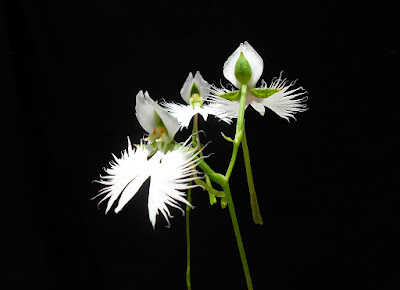Pecteilis radiata found in China, Japan, Korea and Russia. Its natural habitat is the mountain areas, very humid and exposed to the sun, where it grows at an altitude of about 1500 meters. It is now very rare in nature, and is rarely found even in cultivation...
Pecteilis radiata also called as The Ray Shaped Pecteilis, The Egret Flower, Habenaria dianthoides, Habenaria radiata, Habenaria radiata var. dianthoides, Hemihabenaria radiata, Orchis radiata, Orchis susannae, Pecteilis dianthoides, Plantaginorchis dianthoides, Plantaginorchis radiata, Platanthera radiata, is a species of the genus Pecteilis. This species was described by Constantine Samuel Rafinesque in 1836.
IDENTIFY PECTEILLIS RADIATA
Pecteilis radiata found in China, Japan, Korea and Russia. Its natural habitat is the mountain areas, very humid and exposed to the sun, where it grows at an altitude of about 1500 meters. It is now very rare in nature, and is rarely found even in cultivation.
The Ray Shaped Pecteilis is a small to medium sized, erect, cold growing terrestrial with small, ovoid or ellipsoid tubers with an erect, slender terete stem carrying 3 to 7, linear-lanceolate, acuminate, suberect, 5-17 cm in length leaves with basal leaf sheaths.
The Egret Flower blooms in the summer on a terminal inflorescence with lanceolate, acuminate floral bracts and carrying 1 to 3 showy flowers. The flowers are 3 cm in diameter.
PECTEILLIS RADIATA CARE AND CULTURE
Cultural information should only be used as a guide, and should be to be adapted to suit you. Your physical location; where you grow your plants, how much time you have to devote to their care, and many other factors, will need to be taken into account. Only then can you decide on the cultural methods that best suit you and your plants.
Light:
Pecteilis radiata needs a light level of 50000-70000 lux. This species requires direct sun.
Temperature:
During the growth phase this species accepts summer temperatures if they do not rise above 27 ° C. The best results are obtained with 25-26 ° C during the day and 19-20 ° C at night. The rest period instead imposes temperatures from 1 ° C to 10 ° C, which must never go below 0 ° C.
Humidity:
The Ray Shaped Pecteilis comes from very humid environments, so it needs 55-70%.
Substrate, growing media and repotting:
Pecteilis radiata is grown exclusively in pots. As a substrate there are two choices: 1) the sphagnum peat + perlite + sand (1: 1: 1), 2) live sphagnum. The best results come with the first choice. As a pot it is better to choose that of cooked, which allows the roots to stay cooler during the hot months. Keep in mind that this species is grown only outdoors, in a sunny position, with direct sun rays coming in. In winter the plants are left in the same pot and in the same substrate where they spent the summer. At the beginning of spring, when nighttime temperatures start to exceed 13 ° C, the tubers are removed from the pots, the depleted ones are thrown away while the valid ones are planted in the old substrate. The valid tubers, that is, those matured in the previous season, can be recognized by the color (they are lighter) and by the turgidity (they are hard).
Watering:
When the tuber is planted in the spring, he does not have any vegetation yet, so the watering is regular, but not abundant. The substrate must remain moist, but not wet. When the jet comes out, the watering becomes more frequent, and from here until the stem begins to turn yellow in autumn, this species is water frequently and abundantly. The substrate must never become dry.
Fertilizer:
This orchid is rarely fertilized only during the growing period, using 5 drops of the liquid fertilizer for orchids per 1 liter of water. It has very sensitive roots to the presence of mineral salts, so the amount of the fertilizer must be very little. The fertilizations take place every 3 weeks, from May to August. Then they suspend themselves. Sometimes it is a good practice to rinse the vase with the plant under the demineralized water.
Rest period:
When Pecteilis radiata enters the resting phase, the watering is suspended, and the substrate must remain only slightly damp. This is achieved by spraying on the surface of the substrate from time to time. The young tubers must spend the winter, characterized by cool temperatures (from 1 ° C to 10 ° C) and by rather dry conditions (but not completely dry). In the spring these tubers will produce new plants.

















COMMENTS